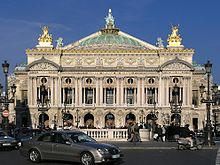| Revision as of 06:40, 22 August 2017 edit121.219.226.195 (talk)No edit summary← Previous edit | Revision as of 08:39, 6 March 2018 edit undoBlaue Max (talk | contribs)Extended confirmed users5,860 editsNo edit summaryNext edit → | ||
| Line 1: | Line 1: | ||
| {{for|Second Empire architecture in Europe|Second Empire architecture in Europe}} | {{for|Second Empire architecture in Europe|Second Empire architecture in Europe}} | ||
| {{for|Second Empire architecture in the United States and Canada|Second Empire architecture in the United States and Canada}} | {{for|Second Empire architecture in the United States and Canada|Second Empire architecture in the United States and Canada}} | ||
| ] in Paris]] | |||
| '''Second Empire''' is an architectural style, most popular in the latter half of the 19th century and early years of the 20th century. It was so named for the architectural elements in vogue during the era of the ].<ref> Copplestone, Trewin, ed., World Architecture: An illustrated history from earliest times, Crescent Books, New York, 1963 pp.310-311</ref> As the Second Empire style evolved from its 17th-century Renaissance foundations, it acquired a mix of earlier European styles, most notably the Baroque, often combined with ] roofs and/or low, square based domes.<ref>], p. 310.</ref> | '''Second Empire''' is an architectural style, most popular in the latter half of the 19th century and early years of the 20th century. It was so named for the architectural elements in vogue during the era of the ].<ref> Copplestone, Trewin, ed., World Architecture: An illustrated history from earliest times, Crescent Books, New York, 1963 pp.310-311</ref> As the Second Empire style evolved from its 17th-century Renaissance foundations, it acquired a mix of earlier European styles, most notably the Baroque, often combined with ] roofs and/or low, square based domes.<ref>], p. 310.</ref> | ||
Revision as of 08:39, 6 March 2018
For Second Empire architecture in Europe, see Second Empire architecture in Europe. For Second Empire architecture in the United States and Canada, see Second Empire architecture in the United States and Canada.
Second Empire is an architectural style, most popular in the latter half of the 19th century and early years of the 20th century. It was so named for the architectural elements in vogue during the era of the Second French Empire. As the Second Empire style evolved from its 17th-century Renaissance foundations, it acquired a mix of earlier European styles, most notably the Baroque, often combined with mansard roofs and/or low, square based domes.
The style quickly spread and evolved as Baroque Revival architecture throughout Europe and across the Atlantic. Its suitability for super-scaling allowed it to be widely used in the design of municipal and corporate buildings. In the United States, where one of the leading architects working in the style was Alfred B. Mullett, buildings in the style were often closer to their 17th-century roots than examples of the style found in Europe.
References
- Copplestone, Trewin, ed., World Architecture: An illustrated history from earliest times, Crescent Books, New York, 1963 pp.310-311
- Copplestone, p. 310.
- Copplestone, p. 311.
| Historicism and Revivalism in architecture and decorative arts | |
|---|---|
| International |
|
| France | |
| Germany, Austria-Hungary | |
| Great Britain | |
| Greece | |
| Italy | |
| Netherlands | |
| Nordic countries | |
| Portugal | |
| Poland | |
| Romania | |
| Russian Empire and USSR | |
| Serbia | |
| Spain | |
| United States | |
| Architecture of the United States | |
|---|---|
| Native and indigenous | |
| Colonial and post-colonial | |
| Early Republic | |
| Mid-19th century | |
| Victorian | |
| Late-19th to mid-20th century |
|
| Post–World War II | |
| Building types and vernacular |
|
| Cities | |
| States | |